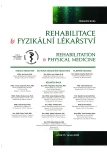Hydrokinesiotherapy of Patients with Chronic Cardiac Failure
Authors:
J. Čelko 1; M. Malay 1; J. Mašán 2; P. Shtin Baňárová 1
Authors‘ workplace:
Trenčianska univerzita Alexandra Dubčeka, Fakulta zdravotníctva, Trenčín
1; Univerzita sv. Cyrila a Metoda v Trnave, Inštitút fyzioterapie, balneológie a liečebnej rehabilitácie Piešťany
2
Published in:
Rehabil. fyz. Lék., 27, 2020, No. 2, pp. 69-73.
Category:
Original Papers
Overview
Background: Hydrokinesiotherapy facilitates a more significant lifestyle change in patients with cardiovascular disease than dry exercise does. Considerably smaller number of studies focus on the burden of assessing cardiac rehabilitation in water than on dry cardiovascular rehabilitation, particularly in patients with chronic heart failure.
Methods: In this contribution we have included research studies published in electronic databases and journals by the end of 2019 as well as our own experience with hydrokinesiotherapy of cardiovascular diseases.
Results and conclusions: At the end of the 20th century, it was recommended to include low - and medium-risk patients who tolerate well the dry exercises with a physiotherapist. Water exercise in high-risk patients has not been well-founded by sufficient research. Since then, research studies with good hydrokinesiotherapy outcomes have been published in patients with severe left ventricular impairment. The studies cited in our contribution indicate that the patients with steady heart failure experience have improved the parameters, while at the same time hydrokinesiotherapy has been proven as an effective and safe alternative to conventional exercise. The water stress testing in patients with ischemic heart disease was proven reliable and safe. While respecting the criteria that emerged from experimental studies and practice, it is possible for hydrokinesiotherapy to become the part of the lifestyle in patients with chronic heart failure.
Keywords:
Immersion – hydrokinesiotherapy – chronic heart failure
Sources
1. ANDERSON, L., THOMPSON, D. R., OLDRIDGE, N. et al.: Exercise-based cardiac rehabilitation for coronary heart disease. Cochrane systematic review and meta-analysis. JACC, 67, 2016, s. 1-12. [PubMed] [Google Scholar].
2. CIDER, Q., WFEAL,V. B..G.., TANG. M. S. et al.: Immersion in warm water induces improvement in cardiac function in patients with chronic heart failure. Eur J. Heart Fail., 2006, 8, s. 308-3013. [PubMed] [Google Scholar].
3. ČELKO, J., GÚTH, A.: Hydrokinezioterapia u pacientov so simultánnym postihnutím pohybového a kardiovaskulárneho ústrojenstva. Rehabilitácia, roč. 50. 2013, č. 3, s. 155-163.
4. ČELKO, J., LIETAVA, J., VOHNOUT, B. et al.: Vývoj názorov na záťaž hypertermálnymi procedúrami. Lek. Obz., roč.59, 2010, č. 7-8, s. 266-271.
5. GRÜNER SVEÄL,V. B., CIDER, A., TÄNG, M. S. et al.: Benefit of warm water immersion on biventricular function in patients with chronic heart failure. Cardiovas Ultrasund, 2009;7,33.
[PMC free article] [PubMed] [Google Scholar]
6. GRÜNER SVEÄL,V. B., TÄNG, M. S., CIDER, A.: Is hydrotherapy an appropriate form of exercise for elderly patients with biventricular systolic heart failure? J. Geriatr. Cardiol., 9, 2012, 4, s. 408-410. doi: 10.3724/SP.J.12632012.06121.
7. ISMAIL, H., MC FARLLANE, J. R., NOJOUMIAN, H.: Clinical outcomes and cardiovascular responses to different exercise training intensities in patients with heart failure. JAAC 1514-522. 10.1016/j.jchf.2013.08.006 [PubMed] [CrossRef] [Google Scholar].
8. KOPROWSKI GARCIA, M., RIZZO, L., YAZBEK-JÚNIOR, P. et al.: Cardiorespiratory performance of coronary artery disease patients on land versus undrwater treadmill tests: a coparative study. Clinics (Sao Paulo), 72, 2017, 11, s. 337-674. doi: 10.6061/clinics/2017(11)104 [PubMed] [CrossRef] [Google Scholar].
9. MEYER, K., LEBLANC, M. C.: Aquatic therapies in patients with compromised left ventricular function and heart failure. Clin. Invest. Med., 31, 2008, 2:E90-7.
10. PELLICORI, P., CLARK, A. L., KALLVIKBACKA-BENNETT, A. et al.: Non-invasive measurement of right atrial pressure by near-infrared spectroscopy: preliminary experience. A repotr from the SICA-HF STUDY. Eur J. Heart Fail., 19, 2017, s. 883-892. doi: 10.1002/ejhf.825. [PubMed] [CrossRef] [Google Scholar].
11. SCOTTISH INTERCOLLEGIATE GUIDELINES NETWORK.: Management of chronic heart failure. SIGN, Edinburgh, 2007 https://www.sing.ac.uk(SIGN Guideline no. 95).
12. SHAH, P., PELLICORI, P., MACNAMARA, A. et al.: Is swimming safe in heart failure? A systematic review. Cardiol Rev., 25, 2017, s. 321-325. doi: 10.10097/CRD.0000000000000154. [PubMed] [CrossRef] [Google Scholar]
13. SHAH, P., PELLICORI, P., KALLVIKBACKA-BENNET, A. et al.: Warm water immersion in patients with chronic herat failure: a pilot study. Clin Res Cardiol., 108, 2019, 5, s. 468-476. doi: 10.1007/s00392-018-1376-2. [PubMed] [CrossRef] [Google Scholar].
14. SCHMID, J. P., NOVEANU, M., MORGER, C. et al.: Influence ov water immersion, water gymnatics and swimming on cardiac output in patients with heart failure. Heart, 93, 2007, 6, s. 722-727. Epub 2006 Dec 12. [PubMed] [CrossRef] [Google Scholar].
15. Vasić, D., Novaković, M., Božič Mijovski, M. Et Al.: Short-term water-and land-based exercise training comparably improve exercise capacity and vascular function in patients after a recent coronary event: A pilot randomized controlled trial. Front Physiol., 16, 2019, 903. doi: 10.3389/fphys.2019.00903. eCollection 2019.
16. ZAKIR, R. M., AL-DEHNEH, A., MAHER, J. et al.: Right ventricular failure in patients with preserved ejection fraction and diastolic dysfunction: an underrecognized clinical entity. Congest Heart Fail., 13, 2007, s. 164-169. [PubMed] [Google Scholar].
Labels
Physiotherapist, university degree Rehabilitation Sports medicineArticle was published in
Rehabilitation & Physical Medicine

2020 Issue 2
Most read in this issue
- Piriformis Syndrome and FAIR Test from the View of Magnetic Resonance
- Evaluation Dynamic Postural Stability – Creation of Reference Values for a Common Young Population in the Czech Republic
- Practical Use of PolyEMG in Rehabilitation. Poutpatient’s. Surface Electromyography (SEMG) and EMG Biofeedback
- The Influence of Phy-siotherapy for Female Urinary Incontinence
